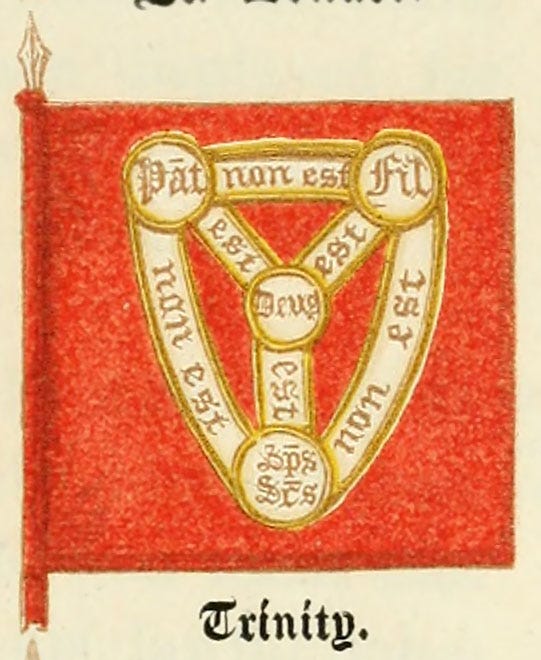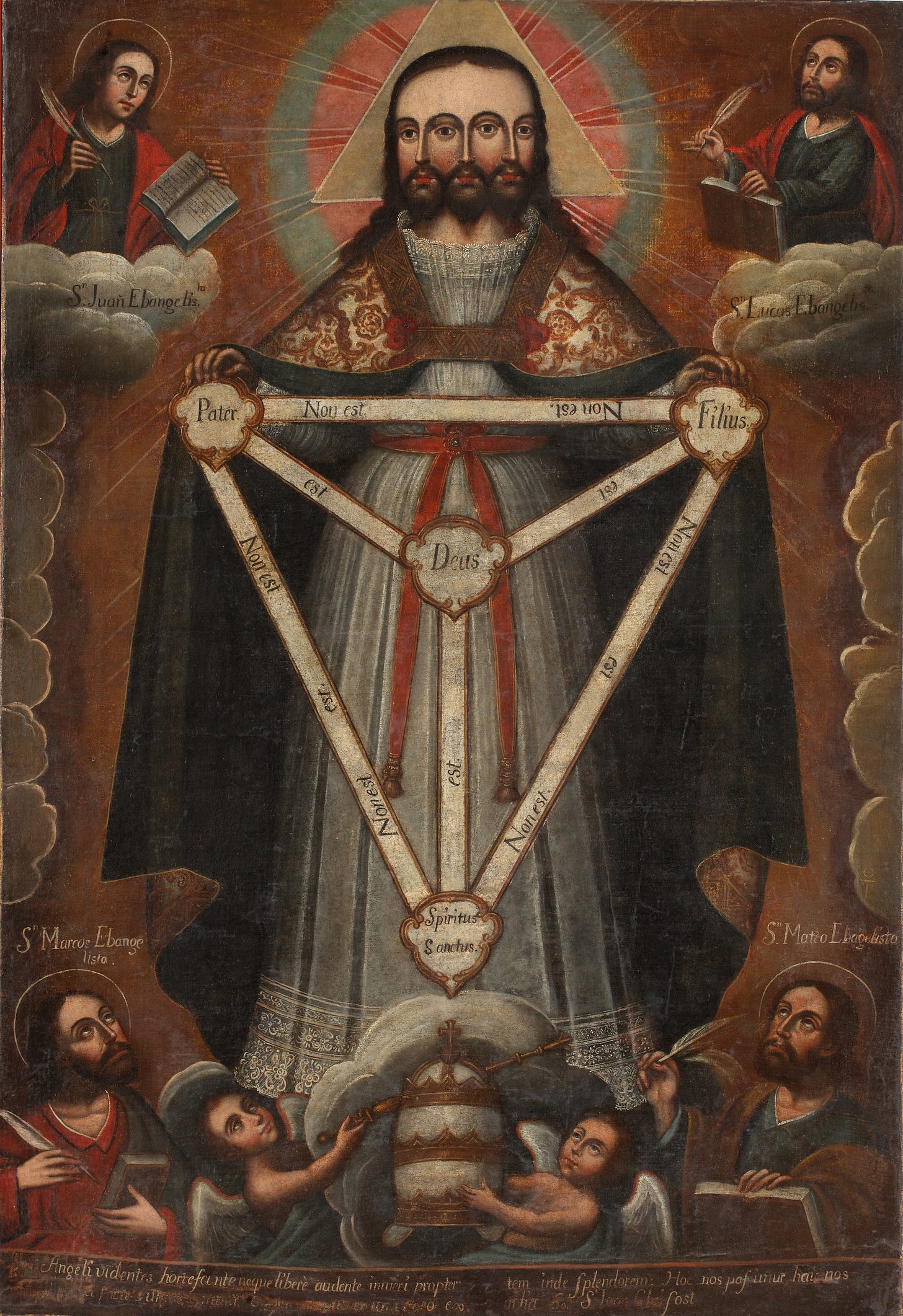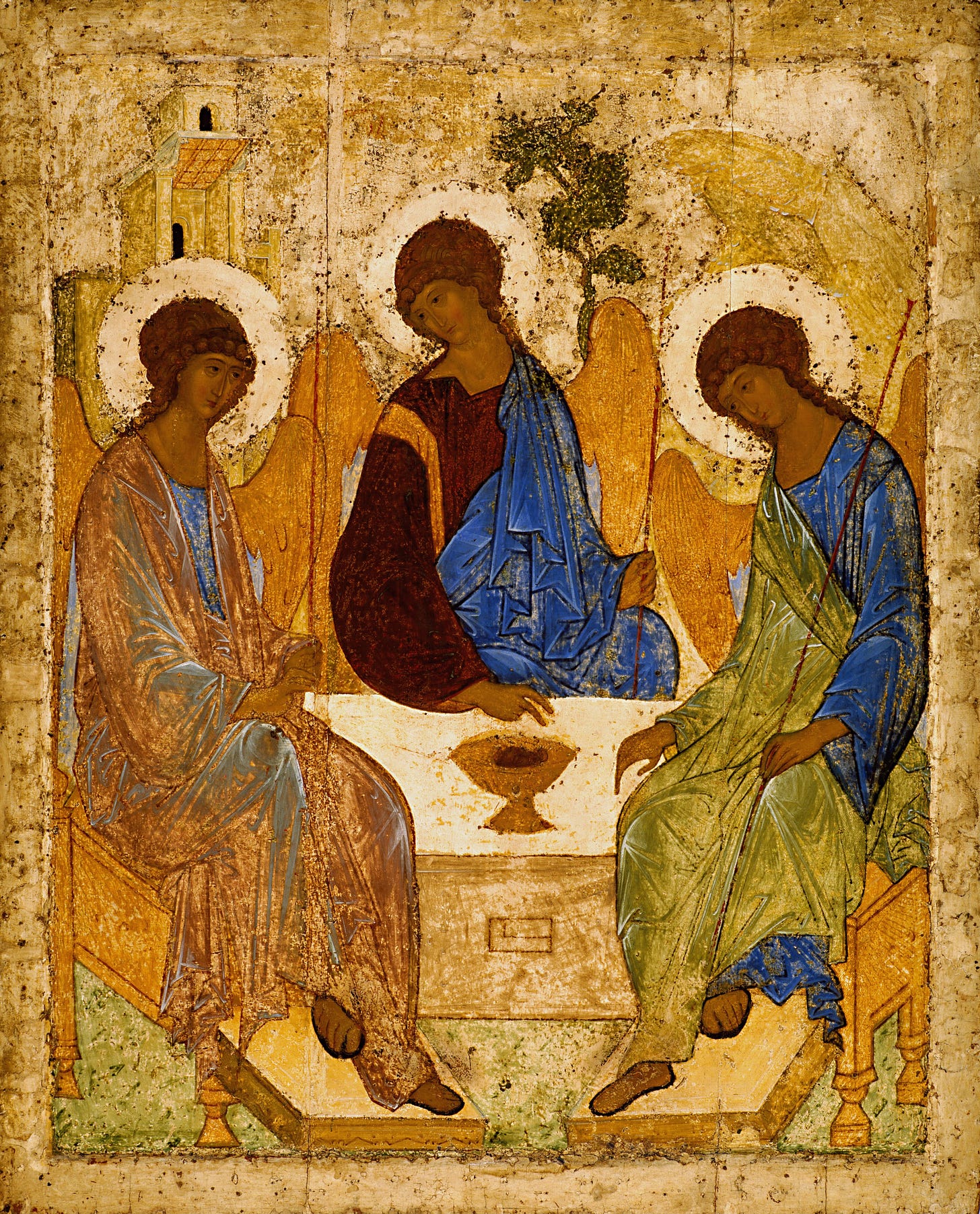Fragment 81
by Gerard Manley Hopkins
It was a hard thing to undo this knot.
The rainbow shines but only in the thought
Of him that looks. Yet not in that alone,
For who makes the rainbows by invention?
And many standing round a waterfall
See one bow each, yet not the same to all,
But each a hand’s breadth further than the next.
The sun on falling waters writes the text
Which yet is in the eye or in the thought.
It was a hard thing to undo this knot.
If rainbows are hard knots to untie, the trinity is a double—make that a triple—knot. Even theologians resort to abstract art as seen here in this 1833 reconstruction of the "Banner of the Trinity" flown by the army of Henry V at the battle of Agincourt.
Search for the “shield of the trinity” and you will see variation upon variation, all of which, try to illustrate a diagram of the Trinity as reasoned by St. Thomas Aquinas. Most pale in comparison to this pixelated representation.
If the theologians have struggled with diagrams artists have also struggled to depict the Three in One, One in Three:
Trifacial Trinity, ca. 1750-70
by an anonymous member of the Cusco School
Oh Lord, help. I know God is beyond us but a four eyed three chinned monster? How might one imagine the Trinity? Is it possible without diagrams or uncanny images?
It might be a leap, but I think Hopkins was getting at the Trinity through the rainbow in that poem. It is only a fragment of an incomplete poem but think about the tri-part image of light he uses. Sun, water, eye.
The sun emits the light. The water refracts the light. The eye perceives the light. An emanation of light split in the body of water molecules and contemplated in the mind of a human. Light (Heaven). Material (Earth). Mind (Spirit).
Even further, Hopkins points out the strange phenomena that a rainbow does not happen in a particular place. If you stand next to a waterfall and see a rainbow in the mist alongside a friend, the rainbow will start in two different places each of you. (This is why finding the pot of gold is impossible, the rainbow shifts as you shift.) The eye of the observer is necessary for the phenomena to appear. When Hopkins says the rainbow is “in the eye,” he is correct according to Popular Science:
From wherever you’re standing, it looks like the rainbow actually exists in some physical form. Maybe it’s perched on a hilltop or stretching across the ocean horizon. Either way, it’s not actually wherever you think it is. If you saw a person facing away from you, seemingly standing beneath a rainbow, that person isn’t seeing the rainbow above them—they’re seeing it almost exactly the way you are, just farther off into the distance. Everyone is seeing it at that same 42-degree angle.
The rainbow requires all three points of the triangle sun—water—eyeball. When all three are at the correct angle the bow is seen. There is a distinction in all three and yet together they make one experience.
It might not be the perfect image of the Trinity, but I like the poem much more than the diagram and the creepy three-faced monster. One thing is certain. The Trinity is a hard knot to untie, perhaps impossible to untie. Even the great icon painter Andrei Rublev had to approach it at an angle.
Holy Trinity (Troitsa), 1425-27
by Andrei Rublev
Rublev made an image of the three angels that Abraham entertained and yet over the centuries the Trinity refracts into the eyes of those who see.






I'm also more in favor of Hopkins' poem as an expression of the trinity than I am of the images you shared. The abstract, diagrammatic image is my favorite of the three; it's almost like some sort of inverted Venn diagram.
When I was a kid I had a book that discussed the Trinity using the metaphor of an apple: skin, flesh, seed are separate yet all are parts of the same apple. Even that description is flawed, though: there is plenty of room for heresy here, as is the case, it seems, with all our human thought about God!
Faced with the impossibility of doing justice to the reality of the Trinity through visual means, perhaps we ought to refrain from even trying to do so—although perhaps that is my Calvinism-informed suspicion of images coming to the surface! Thanks for sharing and commenting on these pictures.
Being ‘at the correct angle’ is the key